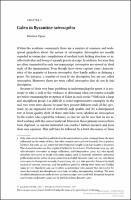Chapter 5 Galen in Byzantine iatrosophia
| dc.contributor.author | Zipser, Barbara | |
| dc.date.accessioned | 2021-04-22T13:07:10Z | |
| dc.date.available | 2021-04-22T13:07:10Z | |
| dc.date.issued | 2019 | |
| dc.identifier.uri | https://library.oapen.org/handle/20.500.12657/48291 | |
| dc.description.abstract | Within the academic community there are a number of common and widespread prejudices about the nature of iatrosophia. Iatrosophia are usually regarded as vernacular compilations of medical texts lacking structure or intellectual value and being of a purely practical scope. In addition, because they are often transmitted in only one manuscript, iatrosophia are viewed as ‘dead ends’ of the transmission. Even though these views capture some characteristics of the majority of known iatrosophia, they hardly suffice in defining a genre. For instance, a number of texts fit the description but are not called iatrosophia. Moreover, there are texts called iatrosophia that do not fit this description. Because of these very basic problems in understanding the genre, it is necessary to take a look at the evidence to determine what iatrosophia actually are before examining the reception of Galen in such works. | en_US |
| dc.language | English | en_US |
| dc.subject.classification | thema EDItEUR::M Medicine and Nursing::MB Medicine: general issues::MBX History of medicine | en_US |
| dc.subject.other | Galen; Byzantine; iatrosophia | en_US |
| dc.title | Chapter 5 Galen in Byzantine iatrosophia | en_US |
| dc.type | chapter | |
| oapen.relation.isPublishedBy | af16fd4b-42a1-46ed-82e8-c5e880252026 | en_US |
| oapen.relation.isPartOfBook | 4b34feed-01e7-483f-a452-638f73b92be1 | en_US |
| oapen.relation.isFundedBy | d859fbd3-d884-4090-a0ec-baf821c9abfd | en_US |
| oapen.relation.isbn | 9789004302211 | en_US |
| oapen.collection | Wellcome | en_US |
| oapen.pages | 13 | en_US |
| oapen.grant.number | 039752 |

